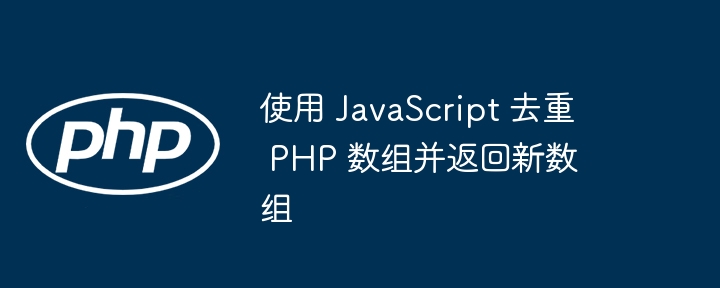Home >Backend Development >PHP Tutorial >Deduplicate PHP array and return new array using JavaScript
Deduplicate PHP array and return new array using JavaScript
- WBOYWBOYWBOYWBOYWBOYWBOYWBOYWBOYWBOYWBOYWBOYWBOYWBOriginal
- 2024-04-28 12:39:011001browse
The steps to use JavaScript to deduplicate PHP arrays are as follows: Use Array.from() to convert PHP arrays to JavaScript arrays. Deduplicate JavaScript arrays using Set objects, returning a new collection containing unique elements. Convert the deduplicated collection into a new JavaScript array using the spread operator (...).

Using JavaScript to deduplicate PHP arrays and return new arrays
Sometimes, we may need to process PHP arrays that contain duplicate values. In JavaScript, we can use the Array.from() method to convert it to a JavaScript array and use the Set object to deduplicate it. This procedure returns a new array containing unique elements.
Syntax:
// 使用 Array.from() 转换为 JavaScript 数组 const jsArray = Array.from(phpArray); // 使用 Set 对象去重 const uniqueSet = new Set(jsArray); // 转换为新的 JavaScript 数组 const uniqueArray = [...uniqueSet];
Example:
Suppose we have a PHP array$phpArray:
$phpArray = [1, 2, 3, 4, 5, 1, 2, 3];
Use JavaScript to remove duplicates:
// 转换并去重 const uniqueArray = [...new Set(Array.from($phpArray))]; // 输出去重后的数组 console.log(uniqueArray); // [1, 2, 3, 4, 5]
Practical case:
Suppose we have an HTML form where the user can select multiple options. We want to get a unique list of choices when submitting the form:
// 获取表单选项
const options = document.querySelectorAll('input[type="checkbox"]:checked');
// 提取值并转换为 JavaScript 数组
const optionValues = Array.from(options).map(option => option.value);
// 使用 JavaScript 去重
const uniqueValues = [...new Set(optionValues)];
// 发送去重后的值到服务器
fetch('submit.php', {
method: 'POST',
body: JSON.stringify({
uniqueOptionValues: uniqueValues
})
});The above is the detailed content of Deduplicate PHP array and return new array using JavaScript. For more information, please follow other related articles on the PHP Chinese website!

